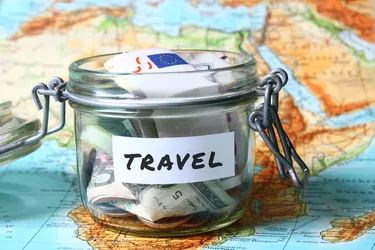
Perhaps you've been inside so much that you're starting to feel caged. And the open road or big sky is really starting to beckon to you. You want to get out and just go – somewhere. Maybe it's the dream vacation you never found time to take, or a week on a beach or a mountain trail. Anywhere but your living room.
Then reality sets in. It's also been a long hard year financially. Does that mean you have to cross that vacation off your to-do-this-year list because you just don't have the money? Not necessarily. You can start a vacation fund. It's doable if you use some common-sense strategies.
Video of the Day
Video of the Day
Surely there's something in your daily or weekly routine that you don't absolutely need to be spending your money on.
Tighten Your Belt
Your first step should be to identify just how much money you need to save. Decide on your dream destination and do your research. Check out the costs of resorts or other accommodations, as well as airfare or gasoline to get there. Don't overlook expenses like meals, tips and activity fees. Have a firm total in mind. This is your goal.
Next, move on to your spending. Surely there's something in your daily or weekly routine that you don't absolutely need to be spending your money on. Keep track of your purchases for at least one week. Use your debit card for each so you have a record of them on your bank statement, or save your receipts if you tend to spend cash. Consider diverting that money to your vacation fund, or at least diverting a portion if you really can't bear giving up that latte every morning.
The same goes with your monthly budget. Give it a good, hard look. Do you really need that top-tier cell service? What about the cable TV package you religiously pay for? You can scale back and divert these expenses to your vacation fund if they're not absolute must-haves. Patriot Federal Credit Union suggests using an image of your ideal vacation site as the background on your phone to keep you motivated.
Consider also: Is Fun In Your Budget?
Dedicate a Savings Account
Avoid the mistake of plopping that saved money down in your savings account or worse, leaving it as a cushion in your checking account. Put it in a separate "vacation account" to avoid any temptation to spend it on other things. Make sure it's not too easily accessible. Consider opening your new account with a separate bank if necessary. It won't do you any good to segregate the money if you can easily move it back to your checking account with a simple tap on your phone.
Make it a point to put your savings into that account once a week, or set up weekly automatic transfers with your bank. Convince yourself that the balance in your vacation account is untouchable for anything other than a bona fide emergency – or your vacation.
Consider also: What Is an All-Inclusive Vacation?
Take on a Side Hustle
Of course, all this will only work if you can create room in your budget for savings. Sometimes that's just not possible. Maybe you've already cut back so your budget is crammed full of must-spends. Depending on how badly you want that vacation, you may have to pick up some extra work.
This could mean taking on a part-time job in addition to your regular job, but that would mean committing scheduled time to a second employer. It may be less painful and more flexible to take on a side hustle instead. Think pet sitting, dog walking or tutoring. Sell stuff on eBay, either of your own creation or possessions that you never really use. Advertise your services and skills on TaskRabbit. And don't overlook gig work, such as driving for Uber or Lyft, during your off hours.
Just make sure to divert all this money to your dedicated vacation account. Then hit the road and enjoy yourself.
Consider also: How to Financially Plan for a Vacation